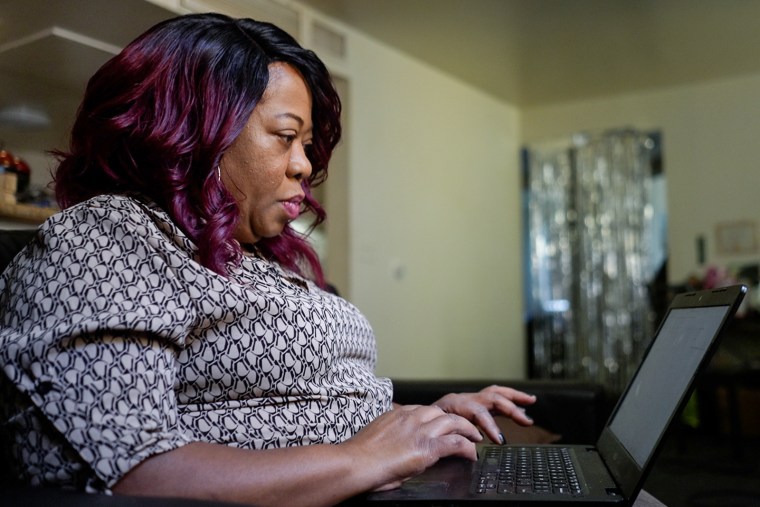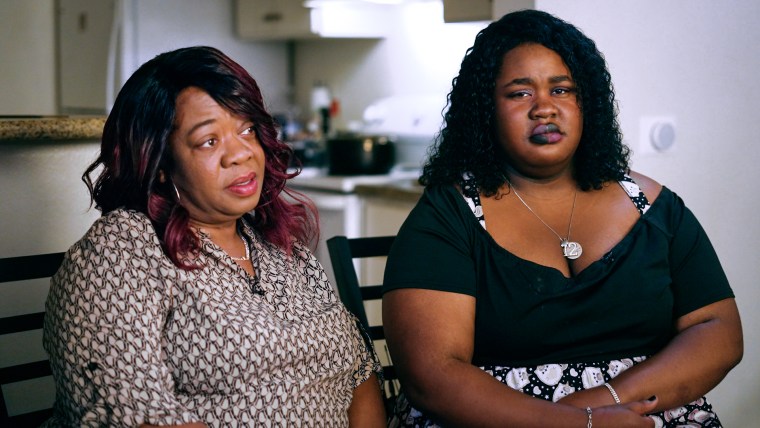But, Banks said, “I just kept putting pressure on them.” With the help of an advocate, Banks asked authorities to issue an Ebony Alert, California’s new notification system to inform the public about missing Black youths.
Two hours after issuing the Ebony Alert, officers pinged the teen’s phone, allowing them to geolocate the device. An hour later, Lelah was reunited with her mother, who credits the alert with saving the teen’s life, despite the lengthy process.
“I don’t know how I ever would have found her,” Banks said.

The alert was put in place to address the disproportionately high number of Black children who go missing or are abducted in California. A year after the system was approved by lawmakers statewide, the Ebony Alert has been deployed 31 times, recovering 27 people, according to the California Highway Patrol, which ultimately issues the alerts. While missing persons advocates like Jasmine Lee, CEO of the Dock Ellis Foundation, say it is a powerful tool, she also is concerned that it’s not deployed nearly enough, and that local law enforcement officers lack proper training to use it.
“I’ve seen it work, but … where is the ongoing training for law enforcement to guarantee they even understand what to do?” Lee said. She said she has helped a dozen families, including Banks’, demand an Ebony Alert for their missing children.
A spokesperson for LAPD told NBC News that an Ebony Alert was issued in Lelah’s case only after it appeared to be necessary.
“LAPD officers take all necessary steps based on the information available at the time to locate missing persons,” a statement from the LAPD read in part. “In this case, the phone tracing and alert issuance were handled through standard investigative procedures, and the timing was dependent on evolving factors in the investigation.”
It turned out Lelah was two miles away from home, outside of a homeless shelter on Skid Row, a part of Los Angeles that has become synonymous with crime, homelessness and poverty. She said she had felt suddenly overcome with loneliness and sadness and wandered out of their home early on July 6, walking until her feet hurt. She stayed in the shelter after lying about her age but had to leave the next day. Months later, Lelah is home and seeing a counselor.

What is an Ebony Alert, and how does it work?
Signed into law by California Gov. Gavin Newsom, a Democrat, and put into effect on Jan. 1, Ebony Alert is a resource for law enforcement to help find missing Black youths and women, ages 12 to 25, who represent a high proportion of missing people in the state and the country. At least 40% of children reported missing in the United States in 2022 were Black, according to the Black and Missing Foundation, despite Black youths making up just 16% of all kids in the U.S.
Once contacted by a law enforcement agency, the California Highway Patrol works with them to determine whether the criteria has been met for an Ebony Alert. If uncertain, the CHP will issue an alert out of caution. Once issued, an Ebony Alert notification with information about the missing person is posted on CHP’s social media pages and sent to phones within a specific geographic area. Similar to an Amber Alert, Ebony Alerts are permitted to be displayed on highway signs and billboards.
To qualify for an Ebony Alert, the missing person must be Black, between the ages of 12-25, suffering from a mental or physical disability and missing under unexplained circumstances. An Amber Alert, on the other hand, requires confirmation that an abduction has happened. In Lelah’s case, she has low blood sugar.
Ebony Alert in action
State Sen. Steven Bradford, who first proposed the alert in the spring of last year, called the program’s rollout a success thus far, given the current data.

“Many times when young Black kids disappear, they’re labeled as runaways,” he said. “So just looking at the data, we thought it was very important that we move forward with a piece of legislation like this.”
However, youth advocates believe the current numbers only reflect part of Ebony Alert’s story and don’t account for individuals who could have been the subject of alerts but weren’t.
According to state data on “Missing and Unidentified Persons” analyzed by NBC News and the Dock Ellis Foundation, a nonprofit that provides education and resources to families of missing people of color, as of Sept. 20 at least 134 Black youths under the age of 18 went missing in California this year, all of whom could qualify for an Ebony Alert, yet only 31 alerts were issued. This means that just 23% of those who could qualify for an alert did benefit from one.
Lee, of the Dock Ellis Foundation, said that the Ebony Alert has saved lives, but thus far it’s suffered from the same shortcomings of the Amber Alert. Because officers determine whether to issue the alert, Lee said the cases of missing Black youth are often not met with the same level of urgency.
“Here’s the thing — you can change the name, but if you have the same people who are approving it then we’re going to end up in the same place,” Lee said.

Other missing victims’ families that Lee’s organization has worked with shared similar frustrations with the Ebony Alert process. Some even have had to tell local police that the alert existed. Then, Lee said, they often feel they have to jump through hoops to finally get it sent out.
That was the experience for Adrienne Hutchinson, whose 19-year-old daughter, Sanai Singh, went missing for three days in February. After contacting police about her daughter’s disappearance, Hutchinson worked with Dock Ellis to understand the Ebony Alert and push police to issue one.
“The police officers on the desk said that they didn’t know what the Ebony Alert was,” Hutchinson said. “I went to another police station and same thing.”
Officers “brushed it off” as if her daughter ran off to “become a prostitute or go to a boyfriend’s house,” she added.
Hutchinson said that only after telling officers that her family would have a news conference that following Monday was an alert sent out. It was issued three days after Singh, who has mental health challenges and was without her medication, first went missing. Just a few hours later, the teen’s phone was pinged by police and her location was identified. A family member — not police — went to recover the teen, Hutchinson said.
When asked about Ebony Alert’s rollout and whether there were plans in place to improve training for law enforcement, a spokesperson for CHP told NBC News that they will continue to work with investigators to determine if a case meets the criteria for an Ebony Alert.
“The CHP knows that when an individual goes missing, time is of the essence,” said Jaime Coffee, director of communications for CHP. “When we are contacted by an investigating agency, our officers work with them to determine the appropriate course of action.”
Future of Ebony Alert
Other states, including Massachusetts, are considering adopting their own version of the Ebony Alert.
While Lee is an advocate for the program, she believes it works best in tandem with community organizations that can ensure that, once a person is found, they have the resources available to remain safe and not go missing again.
In Banks’ and Hutchinson’s cases, two dedicated mothers stayed up looking for their daughters and called on their communities to pitch in. But for others, who don’t have the outreach or the knowledge that the Ebony Alert is a resource, Lee said, the outcomes are often very different.
“They get a police report number,” she said. “They go into the database and that’s it.”

Leave a Reply